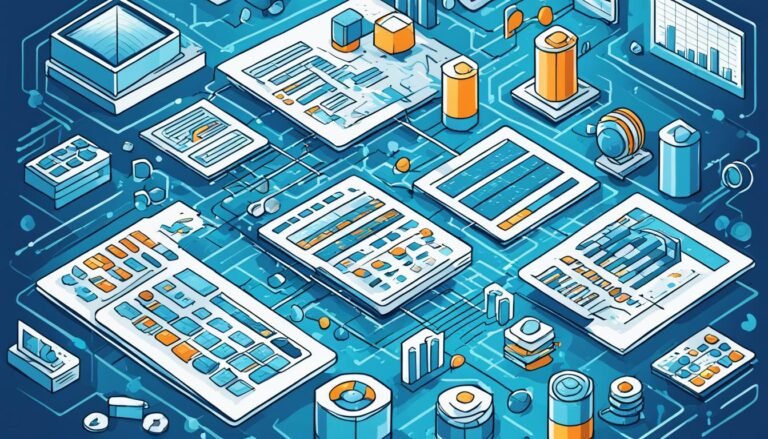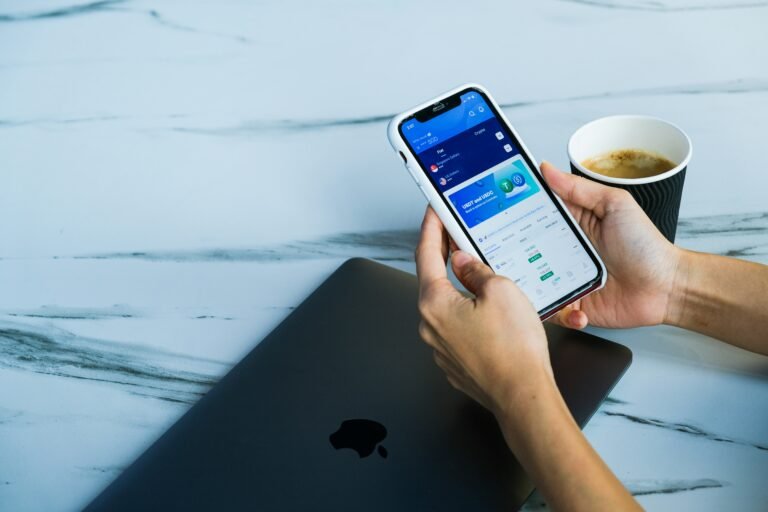Tokenization of Assets: Revolutionizing Investment and Trading
By 2023, the market for tokenized assets could be over $16 trillion. This stat shows the big changes that tokenization innovation can bring. It uses blockchain technology to make asset ownership digital. This means things like real estate or patents become easy to trade online.
With this change, the market works better, costs less, and more people can join in. This is a big step forward in making investing and trading newer and easier for everyone.
Key Takeaways
- Tokenization of assets is projected to reach over $16 trillion by 2023.
- The process involves converting ownership rights into digital tokens.
- Blockchain technology is fundamental to this transformation.
- Tokenized assets enhance market efficiency, reduce costs, and widen market access.
- This innovation paves the way for modernizing both investment and trading practices.
Introduction to Asset Tokenization
Asset digital transformation is changing how we see and use assets with tokenization. This process turns ownership of an asset into a digital token on a blockchain network. It makes investing and trading more transparent and efficient. Let’s explore the concept and history of asset tokenization.
What is Tokenization?
Tokenization converts ownership of physical or intangible assets into digital tokens for trading on a blockchain. It makes transactions secure and visible. This method opens up new chances for many to invest in assets. Before, only a few people could access these investment opportunities.
Brief History of Asset Tokenization
The idea of tokenization started with financial and tech innovations. It dates back to securitization, making asset trading simpler. With the rise of blockchain, it became possible to give these assets a digital form. This evolution shows how we’re striving for a better, safer, and more open financial world.
| Era | Milestone |
|---|---|
| 1980s | Securitization of tangible assets |
| 2009 | Introduction of blockchain technology (Bitcoin) |
| 2013 | Development of smart contracts (Ethereum) |
| 2017 | Initial Coin Offering (ICO) boom |
| 2020s | Increasing adoption of asset tokenization in various sectors |
The Mechanics Behind Digital Asset Tokenization
Digital asset tokenization works with a complex blockchain. It uses many new advancements for safe and clear transactions. It changes how we handle and trade assets in the digital world.
Underlying Blockchain Technology
The heart of blockchain is an unchangeable digital record. It records transactions in a way that’s not controlled by any single body. This feature is key for the trust in digital asset tokenization.
Smart Contracts and Their Role
Smart contract utility is key. These are contracts that carry out their own terms in code. They automate deals, cutting out the middlemen and lowering the risk of error or fraud.
Security and Compliance Measures
For trust in digital assets, strong security and rules must be in place. Compliance means sticking to rules like KYC and AML. These rules help fight fraud and make sure deals are genuine, keeping both sides safe.
| Aspect | Function | Benefit |
|---|---|---|
| Blockchain Infrastructure | Immutable digital ledger | Security, transparency, and immutability |
| Smart Contract Utility | Automated execution of transactions | Eliminates intermediaries, reduces fraud |
| Compliance in Tokenization | Adherence to KYC and AML regulations | Prevents fraud, ensures legitimacy |
Fractionalized Ownership Opportunities
Fractionalized ownership changes how we choose to invest. It lets people own a small part of an asset. Before, you needed a lot of money to get into certain investments. Now, even with less, you can join in and mix up your investments better.
When you own a bit of a tokenized asset, you get a taste of its success. This works well for assets that aren’t easy to sell quickly, like land or expensive art. Now, more people can invest in these things, helping more folks build wealth.
This idea is all about making wealth building open to more. It’s easy for anyone to jump into these kinds of investments now. Tokenizing assets means you don’t need big money piles to start.
- Real estate tokenization allows for partial asset ownership, minimizing entry barriers.
- Fine art tokenization lets individuals invest in masterpieces without purchasing the entire work.
- Accessible investment in these traditionally exclusive markets broadens financial horizons.
In the end, fractional ownership makes investing for anyone. It’s a big move to allow more people to share in wealth growth through investing.
Blockchain-based Securities: A New Wave of Investments
Blockchain-based securities are changing how we invest today. They use blockchain tech to turn things like stocks, bonds, and derivatives into digital assets. This process is known as tokenization.
Types of Tokenized Securities
Tokenized securities bring a lot of variety for investors. There are different types to match various financial goals:
- Equity Tokens: These are like stock shares in a company. They offer dividends and a say in how the company is run.
- Debt Tokens: They work like corporate bonds, giving a steady income for a set time.
- Utility Tokens: These are specific to a platform or app. They give access to its services or products.
Benefits Over Traditional Securities
Blockchain-based securities offer clear advantages over the old way of doing things. They change the game with:
- Reduced Issuance Costs: Tokenizing lowers the costs of starting and running securities.
- Enhanced Liquidity: It’s easier to buy and sell because assets are broken into smaller parts.
- Automated Compliance: Thanks to smart contracts, keeping up with rules is automatic.
These benefits mean traditional securities markets are in for a big change. Blockchain securities make financial markets more efficient and open to everyone.
| Traditional Securities | Blockchain-based Securities |
|---|---|
| High issuance costs | Reduced issuance costs |
| Limited liquidity | Enhanced liquidity through fractional ownership |
| Manual compliance | Automated compliance via smart contracts |
Democratizing Investment Opportunities for Retail Investors
Tokenization is changing how we invest, making it available to more people. It lets everyday investors join big opportunities that were once just for the rich. This shake-up means even small amounts can get you started in markets that seemed too high to climb before.
Retail participation in assets through tokens is a game-changer. Now, you don’t need a lot of money to own a piece of a massive company or a high-priced property. This opens doors for everyone.
It also gives more power to regular folks, creating financial empowerment. Tokenization means more variety in your investments. This helps lower risks and could mean better money in the long run.
But it’s not just about you making more cash. This way of investing makes the entire market stronger. With more people involved, there’s more money moving around. This makes prices fairer and the whole system works better for everyone.
So, to wrap it up, the good stuff that investing in tokenized assets brings includes:
- Access to expensive assets without needing loads of cash
- More ways to build wealth
- A mix of investments for less risk
- Feeling more in control and included in finance
Enhancing Liquidity in Asset Markets
By tokenizing assets, market liquidity gets a big boost. Digital tokens are easier to trade, even at night. This makes more people join in, making markets work better and faster. Also, using blockchain tech means less risk when settling trades quickly.
Tokenization greatly improves asset trading efficiency. Making trades smoother and speedier is key. It’s a new way that’s more open and organized.
- The increased market liquidity lets assets change hands fast.
- Investment real-time settlement cuts down on old problems.
- With better asset trading efficiency, markets run more fluidly.
Finally, these steps aim to make financial markets fairer by getting more people involved. This way, both the market and the traders win.
Tokenized Real Estate: Bridging the Gap between Property and Investors
Real estate tokenization is opening up new doors in the property market. It’s connecting investment properties with a broader set of potential investors. This innovative method allows a property’s ownership to be split into digital shares. This makes it easier for more people to invest, even if they don’t have a lot of money for a big investment.
Case Studies on Tokenized Properties
There are many success stories worldwide about tokenized real estate. One such story is from Aspen Resort in Colorado. They tokenized $18 million worth of property, welcoming in more investors. In New York and Singapore, properties have also been tokenized. This creates a strong example for new investors.
Advantages and Challenges
Real estate tokenization has many benefits. Some include:
- Fractional ownership, letting smaller investors join in
- Being able to sell assets more easily
- Using blockchain for smoother property deals
But, there are hurdles to overcome as well. Regulatory and market acceptance issues can slow things down. However, technology and rules are always changing. This brings hope for a bright future for this kind of investing.
| Benefits | Challenges |
|---|---|
| Fractional ownership | Regulatory hurdles |
| Enhanced liquidity | Market acceptance |
| Streamlined processes | Technological adaptation |
Artwork Tokenization: Bringing Fine Art to the Masses
The way we buy and invest in art is changing, thanks to artwork tokenization. Now, even those without lots of money can own a piece of fine art. By turning artworks into digital tokens, more people can join in. This means anyone can invest in art.
This change is making it possible for everyone to be a part of art ownership. People can buy into an artwork, sharing the value it holds. It’s a big step in making art investment fair and exciting for people everywhere.
Artists are reaping rewards too. This new way of funding lets them connect with supporters easily. They can turn their art into digital tokens to attract global investors. It opens up new opportunities for artists to prosper.
Now, fine art isn’t just for a select few. Everyone can be a part of it. By merging art with technology, artwork tokenization is enriching the art world. It’s making investing in art a lively and open experience for all.
Exploring Tokenized Commodities
Commodity tokens are changing how people invest in things like gold, oil, and crops. They do this by using blockchain to turn real goods into digital tokens. These tokens show the true value of the physical item.
Gold and Precious Metals as Digital Tokens
Gold as a token has become very popular. It makes it easy for people to invest in precious metals. These tokens represent real gold kept safe in vaults. This makes investing in gold simple and without the hassle of owning gold yourself. It helps more people get involved in gold investing by being more accessible and straightforward.
Energy Resources and Agriculture Commodities
Turning energy items like oil and gas and farm goods into tokens is also exciting. It makes trading smoother and shows where things come from. This means people can see prices clearly and markets work better. There are also tokens for green investments that follow good environmental and social rules.
(Repeat Section 1 Title Here as an SEO Strategy)
Tokenization changes the way we look at investing. It uses blockchain technology to make it better than before. With this tech, asset tokenization offers more than the old ways of investing.
Now, investors can own parts of big assets. This makes investing easier, breaks down old barriers, and opens new opportunities.
- Accessibility: Fractional ownership allows individuals to invest in assets previously out of reach.
- Transparency: Blockchain ensures every transaction is public, verifiable, and immutable.
- Efficiency: Smart contracts automate the execution of terms, reducing the need for intermediaries.
| Traditional Investments | Tokenized Investments |
|---|---|
| Involves intermediaries | Decentralized and automated |
| Higher barriers to entry | Lower barriers to entry |
| Lower transparency | High transparency |
Asset tokenization is more than tech advancement. It’s a new way of thinking about investing in our digital world.
Tokenization of Assets: Revolutionizing Investment and Trading
By 2030, the digital asset tokenization market could top $3 trillion. This massive number underlines the huge impact this trend will have. It’s changing how we invest and trade across different asset types, from real estate to fine art and commodities like gold.
Tokenization isn’t just turning physical assets into digital ones. It’s starting an investment revolution that makes finance more open and boosts market activity. This happens through blockchain, making transactions smoother and safer for everyone, from big investors to regular people. So in the end, it’s changing the whole financial world for the better.
Key Takeaways
- Global market for asset tokenization is expected to surpass $3 trillion by 2030.
- Tokenization enables secure and efficient transactions using blockchain technology.
- This trading landscape innovation democratizes investment opportunities.
- Asset tokenization enhances market liquidity and global financial participation.
- Various asset classes, including real estate, fine art, and commodities, are being transformed through tokenization.
Conclusion
The world of investment is changing fast due to tokenization. This tech is combining blockchain and smart contracts to break down old barriers. It makes it easier to buy and sell assets.
Now, you can own a part of big assets like real estate or fine art through tokens. This makes investing available to more people. Markets that were hard to trade in before, like real estate, are becoming more open.
When you own a tokenized asset, it’s safe and following the rules. This means anyone, from a single person to big companies, can join in. The result is a more open and fair financial world.
Looking forward, the future of tokenization looks bright. As blockchain grows and rules improve, there will be more chances for innovation. Tokenization is changing how we invest, connecting the world in new ways. This opens doors to a better global economy.








